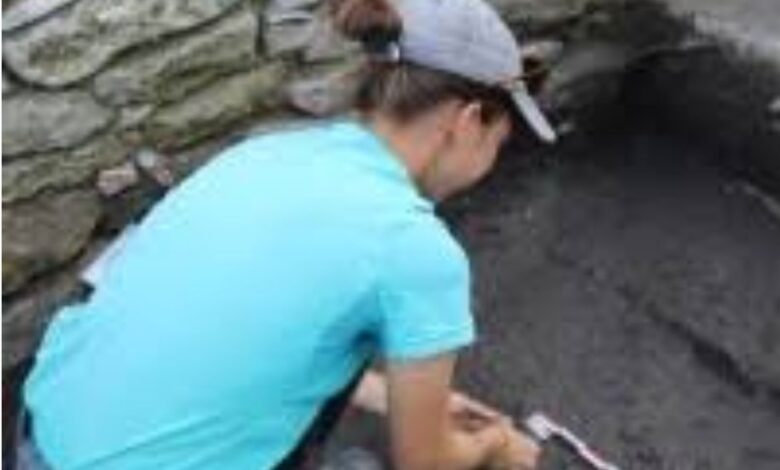Who Is Alice Merchet? A Careful Profile of a Low-Profile Professional

Introduction
Every now and then, a name begins bubbling up in search boxes without an obvious celebrity, headline, or viral post behind it. “Who is Alice Merchet?” is one of those queries. Unlike actors, influencers, or politicians, Alice Merchet is not a widely public figure. Her digital traces point to professional work rather than fame, and to a field—archaeology—that rarely sits at the center of trending culture yet underpins how we learn about human history.
This article takes a careful, evidence-minded approach to examining the available breadcrumbs. Instead of inflating speculation, we’ll explain what can be reasonably inferred, why the public record is thin, and how to understand someone’s work and impact even when they’re not a household name. Along the way, we’ll explore what preventive archaeology is, what an archaeological technician typically does, how institutions like Inrap in France operate, and how to separate credible facts from search-engine noise. Think of this as a guide to responsibly answering, “Who is Alice Merchet?”—and a model for investigating any similarly low-profile professional.
Why There’s So Little About Alice Merchet (and Why That’s Normal)
Many people with meaningful careers keep a deliberately small online footprint. In the sciences and cultural heritage sectors, public visibility often comes through project reports, institutional bulletins, conference proceedings, or brief staff profiles—not through press coverage or entertainment platforms. It’s common to find:
- A bare LinkedIn entry or an institutional staff listing.
- Mentions in site reports or rescue archaeology bulletins.
- Occasional seminar or conference references, often behind paywalls or within academic repositories.
In other words, scarcity of glossy biographical content is not a sign of insignificance. It’s a by-product of how certain professions—especially field-based and team-based ones—document their work.
The Most Plausible Public Profile: An Archaeology Professional
Search results associated with the name Alice Merchet point to a technical role in archaeology, with references to preventive (or “rescue”) archaeology in France. In that context, “technician” is not menial; it’s a skilled position that underpins the success of excavations and studies. Responsibilities typically include:
- Pre-diagnostics and diagnostics: helping determine whether an area slated for development (a road, a building, a pipeline) contains archaeological deposits that warrant excavation or protection.
- Fieldwork: conducting trenching, sampling, mapping, and recording stratigraphy (the layers of soil and cultural material).
- Documentation: detailed field notes, digital recording, photography, GIS data entry, and cataloging of artifacts.
- Laboratory support: washing, sorting, labeling, and preliminary analysis of finds to prepare them for specialist study (ceramics, lithics, faunal remains, charcoal for radiocarbon, etc.).
- Compliance and reporting: contributing observations that feed into preventive archaeology reports required by local and national cultural heritage regulations.
While project directors, research fellows, and specialists often author the final publications, technicians are the operational backbone. Their precision and consistency determine the quality of the archaeological record that scholars will interpret decades from now.
What Is Preventive (Rescue) Archaeology—and Why It Matters
To understand the likely professional context around Alice Merchet, it helps to grasp preventive archaeology. Modern societies are constantly building: housing, highways, wind farms, transit lines. Each project can disturb or destroy buried evidence of past human activity. Preventive archaeology exists to identify, sample, and preserve knowledge before construction alters the landscape.
Key principles:
- Legally embedded: In Europe (including France), development projects often trigger heritage assessments by law.
- Two-phase approach:
- Diagnostic phase (survey, test trenches, coring): determines whether significant deposits exist.
- Excavation phase (if warranted): full-scale recovery, stratigraphic documentation, and interpretation.
- Salvage knowledge, not always artifacts: The “rescue” is often of information—stratigraphy, features, context—because once the site is built over, the context is gone forever.
- Tight timelines: Field teams work to construction schedules; technicians must be efficient and meticulous under time pressure.
- Public value: These datasets feed regional archaeological maps, museum exhibits, and academic research, shaping how we understand settlement, trade, climate adaptation, agriculture, and ritual through time.
The Role of Inrap in France
If you’re seeing references that connect Alice Merchet to French archaeology, you’ll likely encounter Inrap—Institut national de recherches archéologiques préventives. It’s the national body responsible for much of France’s preventive archaeology. Inrap:
- Conducts diagnostics to determine archaeological potential.
- Undertakes excavations when sites warrant deeper exploration.
- Produces technical and scientific reports that become part of the permanent scholarly record.
- Collaborates with regional cultural directorates (DRAC), universities, museums, and local authorities.
- Publishes dig diaries, online resources, and occasional public-facing content to share results.
In this ecosystem, a technician such as Alice Merchet (if indeed attached to Inrap or a partner unit) would be part of interdisciplinary teams: topographers, geoarchaeologists, ceramicists, environmental archaeologists, osteologists, and more.
What an Archaeological Technician’s Day Really Looks Like
Understanding the craft offers a credible view of who “Alice Merchet” is professionally:
Morning: Field Setup & Survey
- Check trench locations, reference points, and safety conditions.
- Calibrate GPS/total station; verify datum (vertical reference used in recording levels).
- Coordinate with the site director on the day’s targets: feature extensions, documentation bottlenecks, or finishing contexts before incoming weather.
Midday: Excavation, Recording, Sampling
- Excavate by context and stratigraphic layer—never by arbitrary spit—to preserve relationships between deposits.
- Record context sheets (soil color via Munsell, composition, inclusions, boundaries).
- Draw plans and sections; log precise coordinates for features (pits, postholes, ditches).
- Collect samples (bulk soil for flotation, micromorphology blocks, charcoal for radiocarbon, residues for phytoliths or starch).
Afternoon: Finds Processing & Data Integrity
- Wash and sort finds; bag and label with site code, trench, context, stratigraphic unit.
- Enter records into the digital site database; back up and cross-check identifiers to avoid data drift.
- Photograph features and finds with scales and color cards for reproducible documentation.
End of Day: Briefing & Logistics
- Daily team debrief: assess what contexts closed, what remains open, what questions emerged.
- Tidy and secure the trench; plan for next day’s tactics based on archaeological strategy and construction deadlines.
It’s demanding, precise, and fascinating work—part science, part craft, and all about stewardship of the past.
Why You’ll Find Name Variants and Look-Alikes
You might notice search results that show “Alice Merchant” or other near-matches. That’s typical with name transliterations, typos, or platform-specific handles. Add to that common search-engine habits (autocorrect, “did you mean…?” suggestions), and you’ll often see spillover identities. To keep things clean:
- Confirm spelling across multiple instances (profiles, reports, conference programs).
- Look for affiliation consistency (e.g., Inrap or a regional archaeology unit).
- Check language and region context; a French institution increases the odds you’re tracking the right person.
When the public record is thin, resist the temptation to conflate people. It’s better to articulate what’s knowable and what remains uncertain.
How to Evaluate Credibility (Without Overreaching)
When you’re profiling a low-profile professional like Alice Merchet, apply these research heuristics:
- Institutional anchors: Mentions on official or semi-official channels (e.g., national institutes, university labs, regional heritage portals) carry more weight than casual blogs.
- Contextual alignment: Do the responsibilities and project types match what we know about preventive archaeology? Are locations and timelines plausible?
- Multiplicity of small signals: A LinkedIn line, a workshop mention, and a brief acknowledgement in a site bulletin—together—form a credible mosaic.
- Avoid single-source biographies: If one post claims sweeping details unmatched elsewhere, treat it as anecdotal.
- State uncertainty: When specifics can’t be verified publicly, say so. Responsible publishing values accuracy over filler.
What “Impact” Looks Like Without Fame
If you’re used to measuring impact in followers or headlines, archaeology offers a different yardstick:
- Cumulative datasets: Technicians contribute to longitudinal knowledge—maps of settlement change, subsistence patterns, and cultural contacts across centuries.
- Rescue value: The unit you document today may be the only record of a site before urbanization covers it for generations.
- Scientific legibility: Clean context data lets future researchers apply new lab methods (e.g., isotopes, aDNA) to old finds—because the records are sound.
- Public history: Museum displays, heritage trails, and school programs often stand on the shoulders of field teams whose names rarely appear in the spotlight.
In this frame, someone like Alice Merchet exemplifies quiet impact: the skill, care, and daily discipline that make high-level interpretations possible.
A Responsible Answer to “Who Is Alice Merchet?”
Pulling it together:
- The most plausible, recurring signal is that Alice Merchet is an archaeology professional engaged in preventive archaeology in France, likely in a technical/field role that supports diagnostics and excavation.
- The online footprint is intentionally limited, consistent with many professionals in cultural heritage where output is technical and team-based.
- Her work, though not celebrity-facing, aligns with a critical public function: safeguarding knowledge about the past amid contemporary development.
That may not satisfy a curiosity for dramatic biography—but it’s a truthful, respectful portrait of real, skilled work that shapes how societies remember themselves.
Practical Tips If You’re Researching Further
- Search in French as well as English (e.g., “archéologie préventive,” “technicienne en archéologie,” “diagnostic archéologique,” “Inrap fiche de poste”).
- Check regional archaeology bulletins (DRAC sites), municipal planning documents, and rescue dig press notes.
- Look for conference abstracts and grey literature (technical reports not always indexed by mainstream search engines).
- When you find a lead, corroborate it twice before attributing it to the person.
Conclusion
So, who is Alice Merchet? Most likely, a field archaeologist/archaeological technician working within France’s preventive archaeology framework—someone whose contribution is measured not in fame but in the accuracy of a context sheet, the clean line of a trench section, and the enduring value of a well-documented site. In a world that often equates visibility with importance, it’s worth remembering that cultural memory rests on countless professionals like her whose names seldom trend, but whose work lasts.
For more thoughtfully researched profiles and accessible explainers that respect evidence over rumor, visit Infizo—we love telling stories that actually hold up.


